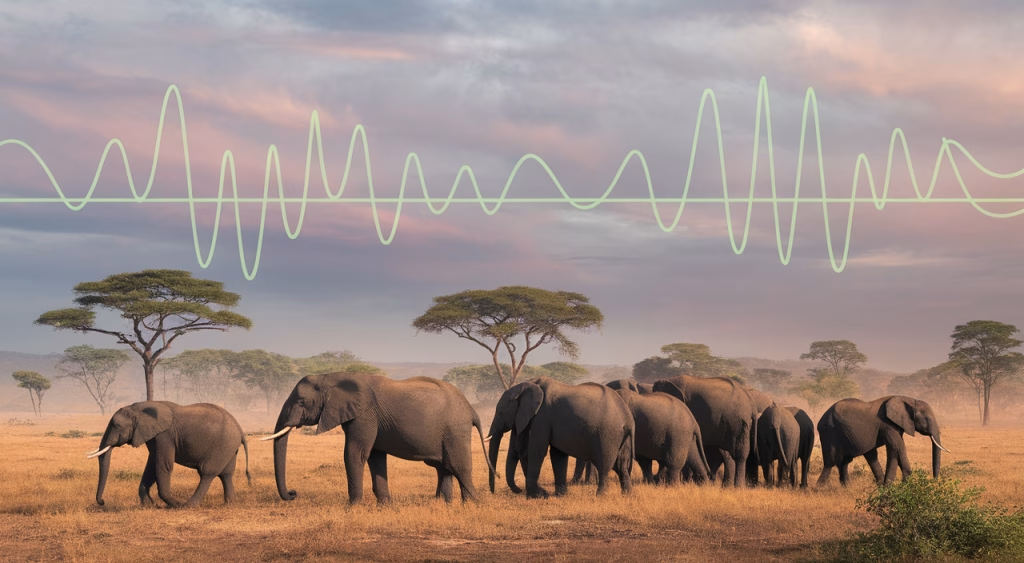How do elephants communicate using infrasound?
Elephants communicate using infrasound — powerful, low-frequency vocalizations that fall below the hearing range of humans. These deep, rumbling sounds can travel over long distances — up to 10 kilometers in some cases — and help elephants coordinate movements, warn of danger, and even communicate reproductive readiness. Using their vocal cords and sensitive sensory systems in their feet and trunk, elephants have developed a secret language nearly inaudible to us, but vital to their survival.
TL;DR: The Secret Language of Elephants
- Elephants use infrasound — sounds below 20 Hz — to communicate over long distances.
- Infrasound helps coordinate herd movements, especially between mothers, calves, and distant groups.
- These vocalizations share messages about danger, mating, and emotional states.
- Elephants detect infrasound through their sensitive feet and trunks, using bone conduction and specialized hearing.
- Conservation researchers analyze infrasound to protect dwindling elephant populations and manage human-elephant conflicts more effectively.
Understanding Elephant Infrasound Communication
When we think about animal communication, we might first imagine birds singing or dolphins chattering underwater. But elephants? Their most powerful conversations happen in a register we cannot hear — infrasound. This low-frequency language, pitched below 20 Hz, acts like a subaudible telegraph across the savannas and forests of Africa and Asia.
Elephants generate these sounds using their massive vocal cords and resonating chambers in their throat and chest. The vibration frequency of some calls is so low that we’d mistake it for a mere tremor in the ground. Yet to another elephant, this sound might mean, “Let’s reunite,” “There’s danger ahead,” or even, “I’m ready to mate.”
It’s not just about talking — it’s also about listening. Elephants have receptors in their feet and trunks that can detect these powerful waves. Through a process called seismic communication, elephants feel the vibrations as they travel along the ground, relaying information silently yet effectively across dozens of square miles. This remarkable infrasound communication system allows elephants to stay connected even when separated by vast distances.
The elephant language is rich in meaning, even though it uses relatively few “words.” Research has shown elephants use infrasound to:
- Summon family members: For example, a matriarch may call her herd together before moving to another location.
- Signal danger: Alarm calls warn the group of predators or human threats.
- Coordinate care for calves: Mothers and aunties use specific rumblings to call their calves or soothe them.
- Declare reproductive status: Females in estrus emit infrasound calls that can attract bulls from miles away.
How Infrasound Coordinates Elephant Herd Movements
Ever seen a herd of elephants move seemingly in sync across a hot African plain? Behind this choreography is infrasound communication. The matriarch — typically the oldest and wisest female — often leads and guides movement decisions. When it’s time to move to a new feeding or watering area, she emits a specific low-frequency rumble. Elephants as far as five, even ten kilometers away, may recognize the call and respond.
Calves rely on these infrasound signals to stay close and oriented with their mother. Young elephants are raised communally, so cooperation and communication are mission-critical. Infrasound reminds family members where to be, helps regroup after a disruption, and avoids messy confusion in unfamiliar or dangerous terrain.
Importantly, it’s not just about sound — elephants sense micro-vibrations through pressure-sensitive cells in their feet. These seismic pathways give a whole new meaning to “feeling the vibe.” It’s as if elephants have acoustic footprints that others can track down across landscapes through their sophisticated infrasound communication network.
Studying Elephant Sound: Detecting the Undetectable
Scientists use high-tech tools to study elephant infrasound communication. Acoustic detectors, vibration sensors, and GPS tracking allow researchers to map calls, determine their purpose, and even decode emotional meanings.
One fascinating discovery: infrasound calls often change based on the time of day, urgency of the message, or social dynamics. Some acoustic researchers even study how tensions within elephant groups play out through their vocal tone — think of it like an elephant soap opera being broadcast via seismic radio waves!
Here’s what researchers often observe when studying elephants infrasound communication:
| Elephant Behavior | Infrasound Message | Estimated Range |
|---|---|---|
| Matriarch begins migration | “Follow me” coordinated call | Up to 10 km |
| Mother locating calf | Low-pitched reassuring tones | 1–3 km |
| Estrus female calling males | Deep frequency reproductive rumbles | 5–7 km |
| Message of danger | Sharp infrasound burst | 3–5 km |
Why Infrasound Matters for Elephant Conservation
When elephants lose their natural communication pathways — due to habitat destruction, noise pollution, or poaching — it’s not just about lost contact. It disrupts an entire survival strategy. Conservationists are increasingly using infrasound data to locate elephant populations, monitor their health, and reduce human-elephant conflict.
By deploying acoustic sensors near protected areas or known movement corridors, researchers can hear the elephants coming — even if they can’t see them. This provides time to redirect nearby communities or prepare ranger interventions, both of which are crucial for keeping elephants (and people) safe. Understanding how elephants communicate using infrasound has become essential for modern conservation efforts.
Additionally, protecting migratory routes ensures that infrasound messages are not fragmented by roads, pipelines, or settlements. An elephant in a disconnected wildlife corridor is, in a sense, muted. And a muted elephant is at a greater risk of isolation or harm.
The Science Behind Elephant Infrasound Signals
The base frequency of elephant rumbles usually ranges between 14 to 35 Hz — too low for humans to hear without equipment. Often, these calls last longer than sounds made by other animals, echoing across silent landscapes. This extended duration helps ensure that other elephants can detect and respond to the infrasound communication.
Their vocal cords, combined with massive lung capacity and resonant anatomical structures, let them produce sound pressures high enough to be detected on seismographs. These aren’t just random grumbles. They’re carefully evolved signals designed for clarity, reach, and resonance.
Final Thoughts: Listening to the Giant’s Whisper
Elephants remind us that communication isn’t always loud or obvious. Sometimes, the most powerful messages come rumbling quietly beneath our feet. Their infrasound conversations offer a glimpse into a deeply empathetic, intelligent, and socially bonded species — one communicating with elegance and precision we’re only beginning to decode.
As researchers, conservationists, and nature enthusiasts, let’s continue to listen — not just to the sounds above our ears, but to the whispers beneath them. Those low rumbles could hold the keys to preserving a species whose voice is vanishing — not only into the air but into silence. Understanding how elephants communicate using infrasound gives us hope for protecting these magnificent creatures for future generations.
Frequently Asked Questions
- How far can elephant infrasound travel?
In open environments, elephant infrasound can travel up to 10 km depending on environmental factors like terrain and wind. - Can humans hear elephant infrasound?
No, most elephant infrasound is below 20 Hz — the lower limit of human hearing — though we might feel it faintly as vibrations. - How do elephants produce infrasound?
Elephants use their long vocal folds within the larynx, combined with huge lung capacity, to generate infrasonic rumbles. - Do baby elephants use infrasound?
Yes, even calves emit and respond to low-frequency sounds, often to stay in contact with their mothers. - How is elephant communication studied?
Researchers use acoustic arrays, seismic sensors, and GPS tags to record and analyze elephant vocalizations and movement patterns. - Is infrasound used by any other animals?
Yes! Whales, giraffes, and some big cats also use low-frequency sounds for communication. But elephants are among the most studied. - Why is infrasound important for conservation?
Monitoring infrasound helps track elephant locations, understand stress signals, and intervene in human-elephant conflicts effectively.





